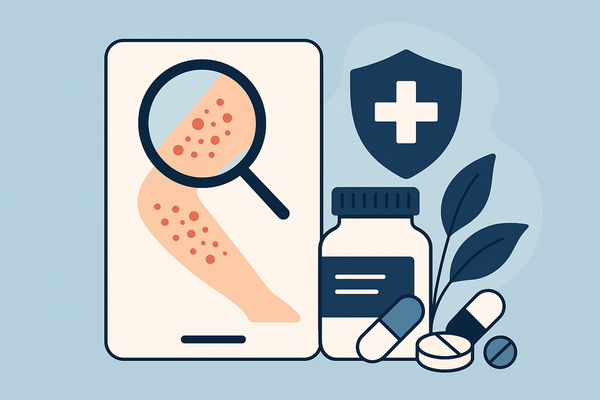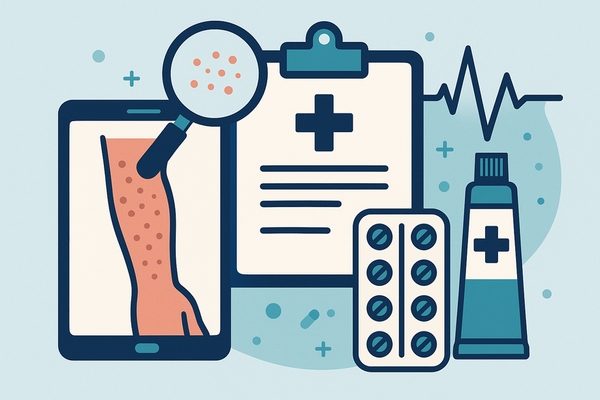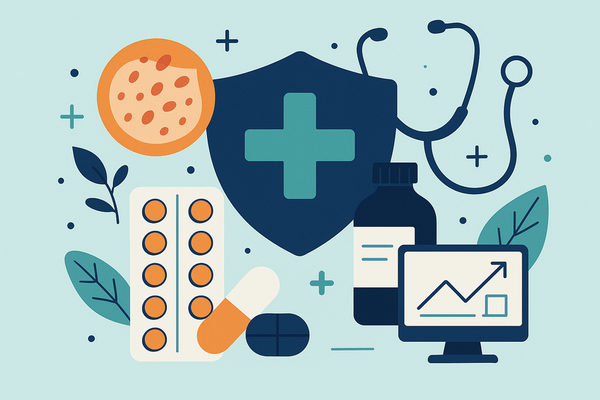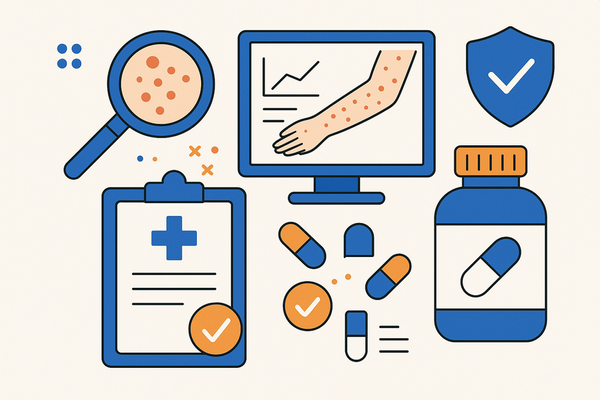Medication Rash Treatment: A Comprehensive Guide
Discover how to identify and manage medication rashes effectively. This guide provides essential tips for medication rash treatment to prevent complications.
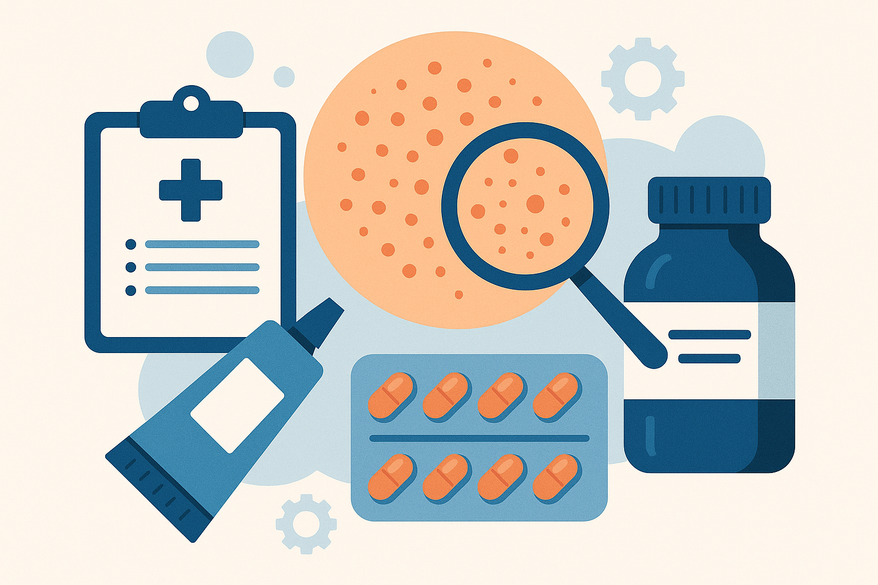
Estimated reading time: 10 min read
Key Takeaways
- Define what medication-induced rashes are and recognize common types.
- Identify high-risk drugs and patient factors for rash development.
- Learn initial response steps and when to seek urgent care.
- Explore treatment options, including antihistamines, steroids, and epinephrine.
- Implement prevention strategies and maintain clear communication with providers.
Table of Contents
- Understanding Medication-Induced Rashes
- Identifying Medication Rashes
- Medication Rash Treatment Options
- Managing and Preventing Medication Rashes
- When to Seek Urgent Medical Attention
- Rash Detector App for Quick Analysis
- Conclusion
1. Understanding Medication-Induced Rashes
Medication-induced rashes are adverse drug reactions that affect the skin. They can look very different depending on the type of rash and the drug involved. Knowing the types, common triggers, and risk factors helps in early recognition and proper medication rash treatment.
1.1 Types of Rashes
- Morbilliform rash: Widespread, measles-like red macules and papules. Often appears 1–2 weeks after starting a new drug. (source: AAFP)
- Urticaria (hives): Raised, itchy wheals or welts that can migrate around the body. Can show up within hours of exposure. (source: Children’s National Health System)
- Fixed drug eruption: Dark red or purple patch that recurs at the same spot each time the drug is taken. Common on lips, arms, or genitals. (source: Cedars-Sinai)
- Severe reactions:
- Stevens-Johnson syndrome (SJS) and toxic epidermal necrolysis (TEN): Widespread blistering and peeling of skin and mucous membranes.
- DRESS (Drug Reaction with Eosinophilia and Systemic Symptoms): Rash plus fever, swollen lymph nodes, and organ involvement. (source: AAAAI)
1.2 Common Offending Medications
Certain drugs are more likely to cause rashes or drug eruptions:
- Antibiotics: Penicillins and sulfonamides are top offenders.
- NSAIDs: Ibuprofen, naproxen, and other non-steroidal anti-inflammatory drugs.
- Anticonvulsants: Phenytoin, carbamazepine often trigger severe reactions.
- Anti-gout drugs: Allopurinol can cause DRESS or exfoliative dermatitis. (source: AAFP)
1.3 Risk Factors for Medication Rashes
Certain people face higher risk for drug hypersensitivity or adverse drug reactions:
- History of drug allergies or prior rash from a medication
- Genetic predisposition (e.g., HLA-B*1502 allele increases risk with carbamazepine)
- Prolonged or repeated drug exposure
- Immunocompromised state (HIV, transplant recipients) (source: AAFP)
2. Identifying Medication Rashes
Spotting a medication rash early is key to prompt medication rash treatment. This section covers the warning signs, how to tell if a rash is benign or serious, and when to call for help.
2.1 Typical Symptoms & Signs
- Redness, itching, hives, or swelling of the skin
- Papules, scaling, or small pimples on face, trunk, or limbs
- In severe cases: blistering, peeling skin, and mucous membrane involvement (eyes, mouth, genitals)
For more on identifying drug-induced rash symptoms.
2.2 Differentiating Benign vs. Serious Rashes
- Benign drug rashes:
- Confined to skin surface only
- Flat red spots or mild hives
- No fever or other body symptoms (source: Children’s National Health System)
- Serious drug eruptions:
- Rapid spread over large areas
- Blisters or skin peeling >10% of body surface
- Mucous membrane lesions, high fever, breathing difficulty (source: Children’s National Health System)
2.3 When to Seek Professional Help
Seek immediate medical care if you see:
- Facial or throat swelling or tightness
- Shortness of breath, wheezing, or chest pain
- High fever plus rash
- Rapidly spreading rash or large blisters
- Any sign of anaphylaxis (fainting, low blood pressure) (source: Children’s National Health System)
2.4 Questions to Ask Your Healthcare Provider
- Can we switch to a safer medication?
- What warning signs mean I must return right away?
- Do I need blood tests or a referral to an allergist?
3. Medication Rash Treatment Options
Treatment for drug-induced rashes ranges from stopping the drug to using medicines that ease symptoms. Always work with your healthcare provider to plan safe care.
3.1 Immediate Cessation of Suspected Drug
- Stopping the culprit drug is the first and most important step.
- Always do this under medical supervision to avoid withdrawal or other risks. (source: NYU Langone)
3.2 Antihistamines
- Over-the-counter options: diphenhydramine, loratadine, cetirizine.
- Prescription H1-antagonists for moderate to severe itching.
- Works by blocking histamine to reduce swelling and itch. (sources: NYU Langone; AAFP)
Learn more about the best anti-itch creams.
3.3 Corticosteroids
- Topical steroids (hydrocortisone cream) for mild, localized rashes.
- Oral or IV steroids (prednisone, methylprednisolone) for severe or widespread eruptions.
- Often tapered over days to weeks to prevent rebound. (sources: AAAAI; DermNet NZ)
3.4 Epinephrine
- The drug of choice for anaphylaxis with airway compromise.
- Administer via autoinjector (EpiPen) at first sign of life-threatening reaction. (source: Children’s National Health System)
3.5 Supportive Care
- Emollients and fragrance-free moisturizers to protect skin barrier.
- Cool compresses to soothe itching or burning.
- Loose cotton clothing to avoid friction.
- Stay well-hydrated to support skin healing. (sources: DermNet NZ; Cedars-Sinai)
3.6 Self-Care Tips
- Do not scratch – it can lead to infection or scarring.
- Keep a medication and reaction diary for future reference.
- Note drug names, doses, dates, and rash details.
4. Managing and Preventing Medication Rashes
After healing, focus on prevention and good communication with your care team. This reduces the chance of repeat reactions.
4.1 At-Home Management Steps
- Confirm with your provider before stopping or changing any drug.
- Use antihistamines, cold compresses, and topical steroids as directed. (sources: NYU Langone; AAFP; DermNet NZ)
- Keep skin clean and dry.
4.2 Preventive Measures
- List all known drug allergies clearly in your health records.
- Wear medical ID jewelry if you have severe allergies.
- Closely monitor new prescriptions, especially antibiotics and anticonvulsants.
4.3 Communication with Healthcare Providers
- Report any new or recurring rash immediately.
- Ask about alternative drugs or allergy testing if needed. (source: AAFP)
5. When to Seek Urgent Medical Attention
Some medication rashes can progress to medical emergencies. Know the red-flag signs and risks if untreated.
5.1 Red Flags
- Airway or facial swelling, difficulty breathing, hypotension
- High fever with widespread blistering or skin peeling >10% body surface
- Mucous membrane ulcers in eyes, mouth, or genitals
- Signs of DRESS: fever, rash, swollen lymph nodes, liver or kidney issues (sources: Children’s National Health System; AAAAI)
5.2 Potential Complications if Untreated
- Progression to Stevens-Johnson syndrome or toxic epidermal necrolysis
- Secondary bacterial skin infections requiring antibiotics
- Long-term damage to liver or kidneys from systemic drug reaction (source: AAFP)
For a deeper dive into managing drug allergy rashes.
Rash Detector App for Quick Analysis
In addition to professional care, using AI tools like Rash Detector can help you quickly assess rash characteristics. Simply upload clear photos to receive an instant analysis, aiding early intervention.
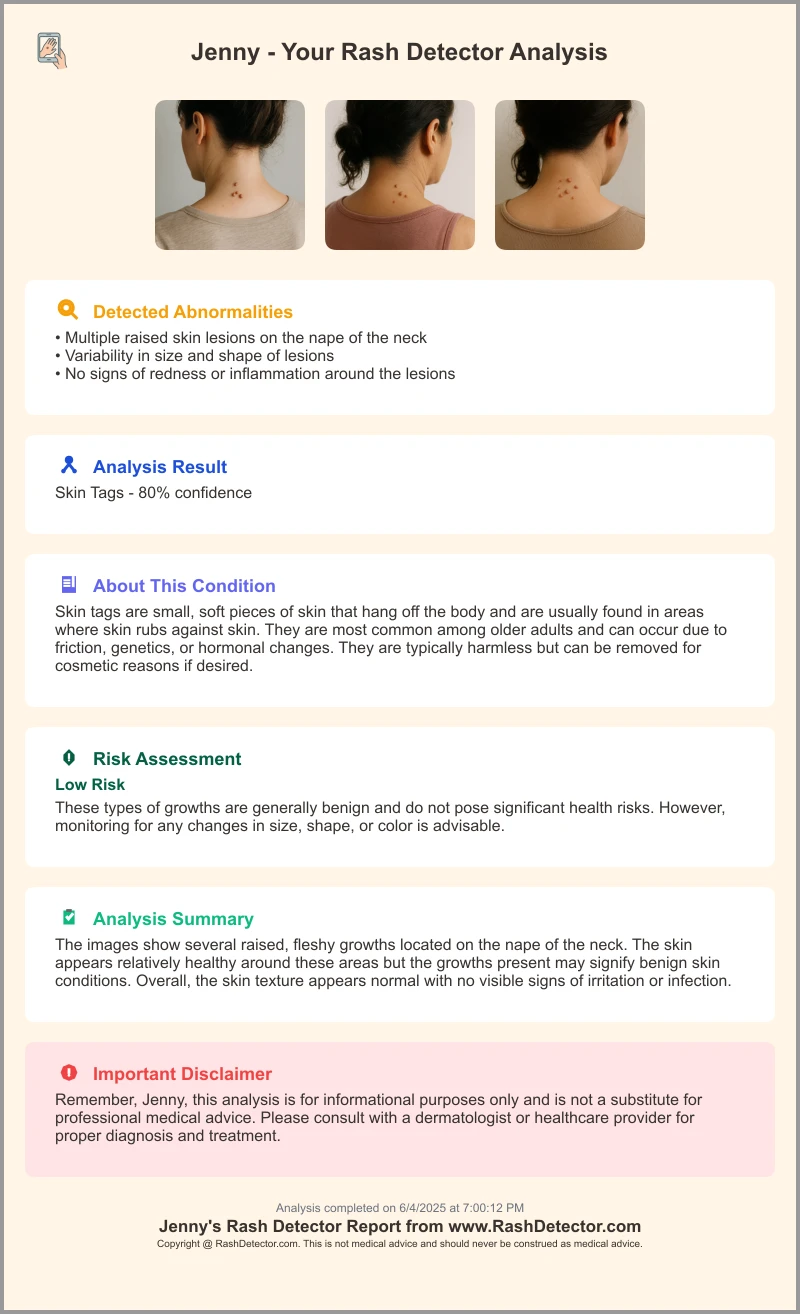
Conclusion
Early recognition and swift medication rash treatment are essential to avoid serious harm. Stopping the offending drug, using antihistamines or corticosteroids, and seeking medical care when warning signs appear can stop a rash from becoming life-threatening. Keep clear records of drug allergies, communicate openly with your healthcare team, and follow professional advice. With these steps, medication rash treatment can be safe, effective, and tailored to your needs.
FAQ
- What causes medication rashes? Medication rashes occur when the immune system reacts to a drug or its metabolites, leading to skin inflammation and various rash patterns.
- How soon after taking a drug can a rash appear? Rashes can develop within hours (e.g., urticaria) or days to weeks (e.g., morbilliform) after starting a new medication.
- Should I stop the medication if I develop a mild rash? Always consult your healthcare provider before stopping any drug; they will assess severity and recommend the safest course.
- How long does a drug-induced rash last? With proper treatment and drug cessation, most rashes resolve in 1–3 weeks, though severe reactions may take longer.
- Can I prevent rashes if I have a known drug allergy? Yes. Carry allergy documentation, wear medical ID, and discuss alternatives or allergy testing with your provider before new prescriptions.


